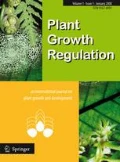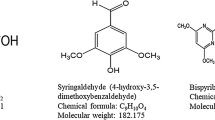Abstract
This study was conducted to evaluate the inhibitory potential of P. harmala leaf, stem and root extract on germination and growth of Avena fatua L. and Convolvulus arvensis L., as well as identification of the phytotoxic substances responsible for this activity. According to our results, the degree of toxicity of different P. harmala plant parts can be arranged in the following order: leaves > stems > roots. The two test species differed in their sensitivity to P. harmala extracts. Inhibitory effect on shoot length and seedling dry weight was more pronounced in C. arvensis, whereas higher reduction in germination, root length and total chlorophyll content occurred in A. fatua. A significant amount of water-soluble phenolic acids were found in P. harmala plant extracts. Total phenolic acids content was higher in leaf extracts when compared to that of stem or root extracts. Seven phenolic acids including gallic acid, vanillic acid, 4-hydroxybenzoic acid, 3,4-dihydroxybenzoic acid, caffeic acid, syringic acid and ferulic acid were found in P. harmala leaf extracts. On the other hand, we identified four phenolic acids from stem (galllic acid, vanillic acid, 3,4-dihydroxybenzoic acid and caffeic acid) and root (galllic acid, 4-hydroxybenzoic acid, syringic acid and cinnamic acid) extracts. The greater number of growth inhibitors detected in the leaves might explain the stronger inhibitory activity. Overall, our results suggest that P. harmala might be used as a natural herbicide for weed control and consequently reduce dependence on synthetic herbicides.





Similar content being viewed by others
References
An M, Pratley JE, Haig T (2000) Phytotoxicity of Vulpia residues: IV. Dynamics of allelochemicals during decomposition of Vulpia residues and their corresponding phytotoxicity. J Chem Ecol 26:2603–2617
Anderson RC, Loucks OL (1966) Osmotic pressure influence in germination tests for antibiosis. Science 52:771–773
Arshad N, Zitterl-Eglseer K, Hasnain S, Hess M (2008) Effect of Peganum harmala or its beta-carboline alkaloids on certain antibiotic resistant strains of bacteria and protozoa from poultry. Phytother Res 22:1533–1538
Batish DR, Singh HP, Rana N, Kholi RK (2006) Assessment of allelopathic interference of Chenopodium album through its leachates, debris extracts, rhizosphere and amended soil. Arch Agron Soil Sci 52:705–715
Batish DR, Arora K, Singh HP, Kohli RK (2007) Potential utilization of dried powder of Tagetes minuta as a natural herbicide for managing rice weeds. Crop Prot 26:566–571
Bewley JD, Black M (1986) Seeds, physiology of development and germination. Plenum Press, New York
Chon S-U, Jang H-G, Kim D-K, Kim Y-M, Boo H–O, Kim Y-J (2005) Allelopathic potential in lettuce (Lactuca sativa L.) plants. Sci Hortic 106:309–317
Chopra RN, Nayar SL, Chopra IC (1986) Glossary of Indian medicinal plants (including the supplement). Council of Scientific and Industrial Research, New Delhi
Ebana K, Yan W, Dilday RH, Namai H, Okuno K (2001) Variation in the allelopathic effect of rice with water soluble extracts. Agron J 93:12–16
Einhellig FA, Rasmussen JA (1979) Effects of 3 phenolic-acids on chlorophyll content and growth of soybean and grain-sorghum seedlings. J Chem Ecol 5:815–824
Hanley M, Whiting M (2005) Insecticides and arable weeds: effects on germination and seedling growth. Ecotoxicology 14:483–490
Hodgson JG, Mackey JML (1986) The ecological specialisation of dicotyledonous families within a local flora: some factors constraining optimisation of seed size and other possible evolutionary significance. New Phytol 104:497–515
Holm LG, Plucknett DL, Pancho JV, Herberger JP (1977) The world’s worst weeds. Distribution and biology. The University Press of Hawaii, Honolulu
Hong NH, Xuan TD, Tsuzuki E, Terao H, Matsuo M, Khanh TD (2004) Weed control of four higher plant species in paddy rice fields in Southeast Asia. J Agron Crop Sci 190:59–64
Inderjit D, Duke SO (2003) Ecophysiological aspects of allelopathy. Planta 217:529–539
Inderjit D, Foy CL (1999) Nature of the interference mechanism of mugwort (Artemisia vulgaris). Weed Technol 13:176–182
Inderjit N, Nilsen ET (2003) Bioassays and field studies for allelopathy in terrestrial plants: progress and problems. Crit Rev Plant Sci 22:221–238
Iqbal Z, Hiradate S, Noda A, Isojima S-I, Fujii Y (2002) Allelopathy of buckwheat: assessment of allelopathic potential of extract of aerial parts of buckwheat and identification of fagomine and other related alkaloids as allelochemicals. Weed Biol Manag 2:110–115
Kartal M, Altun ML, Kurucu S (2003) HPLC method for the analysis of harmol, harmalol, harmine and harmaline in the seeds of Peganum harmala L. J Pharmaceut Biomed 31:263–269
Khanh TD, Xuan TD, Hahn SJ, Chung IM (2004) Methods to screen allelopathic accessions of wheat, barley, oat, sorghum and cucumber for weed control. Allelopath J 14:145–166
Kobayashi K (2004) Factors affecting phytotoxic activity of allelochemicals in soil. Weed Biol Manag 4:1–7
Leela D (1995) Allelopathic effects of purple nutsedge (Cyperus rotundus L.) tubers on growth of field crops. Allelopath J 2:89–92
Lichtenthaler HK (1987) Chlorophylls and carotenoids: pigments of photosynthetic biomembranes. Methods Enzymol 148:350–382
Lin D, Tsuzuki E, Dong Y, Terao H, Xuan TD (2004) Potential biological control of weeds in rice fields by allelopathy of dwarf lilyturf plants. BioControl 49:187–196
Macias FA, Castellano D, Molinillo JMG (2000) Search for a standard phytotoxic bioassay for allelochemicals. Selection of target species. J Agric Food Chem 48:2512–2521
Macías FA, Chinchilla N, Varela RM, Molinillo JMG (2006) Bioactive steroids from Oryza sativa L. Steroids 71:603–608
Monsef HR, Ghobadi A, Iranshahi M, Abdollahi M (2004) Antinociceptive effects of Peganum harmala L. alkaloid extract on mouse formalin test. J Pharm Pharmaceut Sci 7:65–69
Oueslati O (2003) Allelopathy in two durum wheat (Triticum durum L.) varieties. Agric Ecosyst Environ 96:161–163
Oueslati O, Ben-Hammouda M, Ghorbal MH, Guezzah M, Kremer RJ (2005) Barley autotoxicity as influenced by varietal and seasonal variation. J Agron Crop Sci 191:249–254
Parvez S, Parvez M, Fujii Y, Gemma H (2004) Differential allelopathic expression of bark and seed of Tamarindus indica L. Plant Growth Regul 42:245–252
Prati D, Bossdorf O (2004) Allelopathic inhibition of germination by Alliaria petiolata (Brassicaceae). Am J Bot 91:285–288
Reigosa MJ, Souto XC, Gonz′lez L (1999) Effect of phenolic compounds on the germination of six weeds species. Plant Growth Regul 28:83–88
Reinhardt CF, Bezuidenhout SR (2001) Growth stage of Cyperus esculentus influences its allelopathic effect on ectomycorrhizal and higher plant species. In: Kohli RK, Singh HP, Batish DR (eds) Allelopathy in agroecosystems. Food Products Press, Binghamton, pp 323–333
Rice EL (1984) Allelopathy. Academic Press, Orlando
Sampietro DA, Vattuone MA (2006) Sugarcane straw and its phytochemicals as growth regulators of weed and crop plants. Plant Growth Regul 48:21–27
Singh HP, Batish DR, Kaur S, Kohli RK (2003a) Phytotoxic interference of Ageratum conyzoides with wheat (Triticum aestivum). J Agron Crop Sci 189:341–346
Singh HP, Batish DR, Kohli RK (2003b) Allelopathic interactions and allelochemicals: new possibilities for sustainable weed management. Crit Rev Plant Sci 22:239
Swain T, Hillis WE (1959) The phenolic constituents of Prunus domestica I. The quantitative analysis of phenolic constituents. J Sci Food Agric 10:63–68
Tawaha AM, Turk MA (2003) Allelopathic effects of Black Mustard (Brassica nigra) on germination and growth of Wild Barley (Hordeum spontaneum). J Agron Crop Sci 189:298–303
Wardle DA, Nicholson KS, Ahmad M (1992) Comparison of osmotic and allelopathic effects of grass leaf extracts on grass seed germination and radical elongation. Plant Soil 140:315–319
Weston LA, Duke SO (2003) Weed and crop allelopathy. Crit Rev Plant Sci 22:367
Xuan TD, Tsuzuki E (2004) Allelopathic plants: Buckwheat (Fagopyrum spp.). Allelopath J 13:137–148
Xuan TD, Shinkichi T, Hong NH, Khanh TD, Min CI (2004) Assessment of phytotoxic action of Ageratum conyzoides L. (billy goat weed) on weeds. Crop Prot 23:915–922
Xuan TD, Shinkichi T, Khanh TD, Chung IM (2005) Biological control of weeds and plant pathogens in paddy rice by exploiting plant allelopathy: an overview. Crop Prot 24:197–206
Author information
Authors and Affiliations
Corresponding author
Rights and permissions
About this article
Cite this article
Sodaeizadeh, H., Rafieiolhossaini, M., Havlík, J. et al. Allelopathic activity of different plant parts of Peganum harmala L. and identification of their growth inhibitors substances. Plant Growth Regul 59, 227–236 (2009). https://doi.org/10.1007/s10725-009-9408-6
Received:
Accepted:
Published:
Issue Date:
DOI: https://doi.org/10.1007/s10725-009-9408-6




